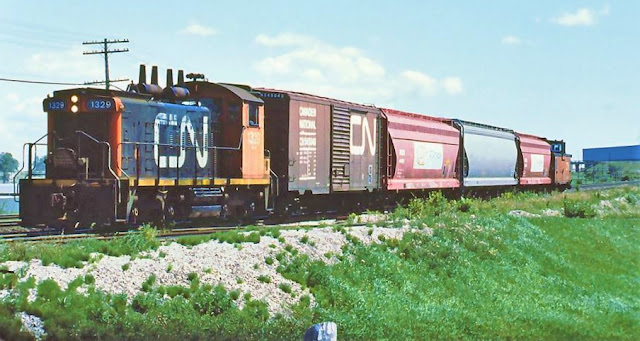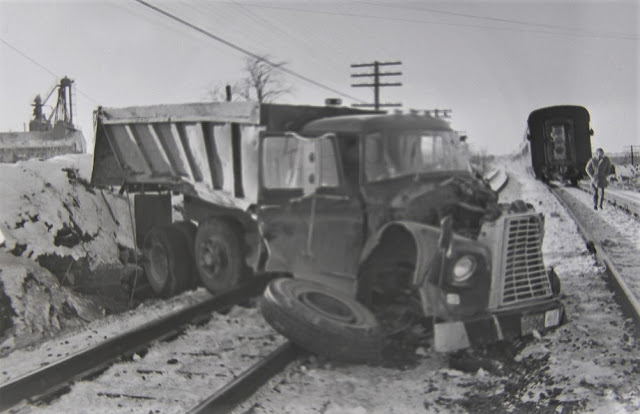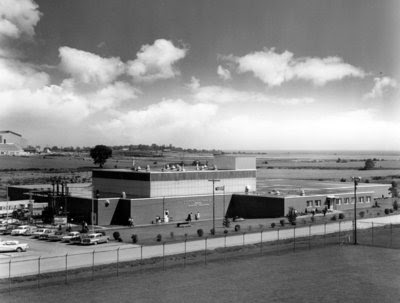Thursday, September 29, 2022
My New Yashica Camera, 1984
Friday, September 23, 2022
The Wreck the Day Before the Turbo Wreck
 Black and white photos in this post are from the Queen's University Archives' Whig-Standard Fonds. The following photos, taken by a Whig photographer, they show the aftermath of the December 9 crash. An account, along with only one photo (top photo), appeared as a twofer in the December 10 newspaper, along with the Turbo crash. The beauty of these archival images, which are held in the form of negatives, is that there are many more than what you might find perusing old newspapers. The job of the editor was to select the minimum number of photos that would tell a story, closely-cropping them, and leaving lots of room for other stories and of course, advertising!
Black and white photos in this post are from the Queen's University Archives' Whig-Standard Fonds. The following photos, taken by a Whig photographer, they show the aftermath of the December 9 crash. An account, along with only one photo (top photo), appeared as a twofer in the December 10 newspaper, along with the Turbo crash. The beauty of these archival images, which are held in the form of negatives, is that there are many more than what you might find perusing old newspapers. The job of the editor was to select the minimum number of photos that would tell a story, closely-cropping them, and leaving lots of room for other stories and of course, advertising!Friday, September 16, 2022
Industry Profile: DuPont's Whitby Facility
- Sclair Film linear low-density polyethylene film, named for its Sarnia production site along the St. Clair River (for coffee, cheese, medical instrument and paper packaging)
- Vexar plastic netting (1960 - for produce packaging and fencing)
- Herox nylon monofilament (1967 - for brush bristles and thread)
- Dartek nylon film (1972 - for meat and cheese packaging, industrial applications)
- Aug 19/10 7 total
- Dec 16/10 2-2-1
- Mar 8/11 2-2, 1 off-spot
- Aug xx/11 2-2, 5 off-spot
- Sep 22/11 1-2-2-4
- May 15/12 2-2-2-0
- Jul 17/12 3-2-1-2
- Sep 27/12 1-2-2-2
- Feb 25/13 2-2-2
- Sep 18/14 1-2-2-3
- Nov 1/15 2-1-1-3
- Jun 5/16 3-2-2-4
- Mar 28/17 2-2-1
- Jul 21/17 1-3-2-2
- Oct 30/17 2-3-2-3
- Dec 12/17 2-1-2-3
- Jul 6/18 2-2-2-2-4
- Oct 2/18 1-1-2-3-4
- WS34 - 250' added <2014
- WS32 - 393'
- WS31 - 570'
- WS30 lead - 1220'
- WS33 - 710'

- 1958 - construction of the DuPont of Canada plant begins.
- 1981 - $3 million expansion for polyethylene film production.
- 1983 - $2 million expansion for a new plastic film line.
- 1984 - 43,000 sq.ft. warehouse was added on the plant's 25th anniversary. Employment had grown from an initial 75 to 300, with 14 original employees still on staff.
- 1986 - $4 million expansion included a packaging technical centre, offices and laboratories.
- 1987 - the plant's footprint was 215,000 square feet.
- 1994 - DuPont's Sclair technology and polyethylene business was acquired by Novacor, though the Whitby plant was not part of the deal.
- 2001 - the Whitby operation is rebranded Enhance Packaging Technologies Inc., a wholly-owned subsidiary of DuPont Canada producing performance films.
- 2002 - Enhance Packaging Technologies acquired US-based bag-in-box manufacturer Liqui-box, thereafter a DuPont Canada company Liqui-Box Canada, Inc.
- 2007 - DuPont Liquid Packaging Systems sold the Whitby facility to South Carolina-based Exopack Performance Films. At the time of sale, Sclairfilm and Dartek were the main product lines and employment stood at 129. Exopack continued to supply Liqui-Box with products from Whitby.
- 2013 - Exopack is rebranded as Coveris High Performance Packaging.
- 2018 - the age of consolidation sees Montreal-based Transcontinental Packaging acquire Coveris, owner of 21 packaging plants, with Whitby its sole Canadian property employing 140.
Lots o' links:
- Throwback! This 2018 photo taken at Whitby, ironically shows a Sclair car on CN No 376, likely destined for Brockville, not Whitby.
- CN 4601 at the South Blair Street crossing in 1988, with the DuPont lead to right.
- There are several albums of 2014-15 photos posted to Metrolinx' Flickr page, the first one showing the closing up of the South Blair Street level crossing.
- A pre-overpass 2010 Thomas Blampied photo showing the switch to the DuPont lead.
Running extra:
Stop the presses! Rapido Trains Inc. is releasing a new run of VIA coaches, including the "D&H" scheme. Stop stopping the presses! Rapido has released their final pre-production sample of the CPR D-10. All that's missing is the "Spirit of Sir John A." lettering. Stop talking about nothing about Rapido! But first, read this Q&A where Jason admits that Kingston is his greatest modelling success! (Fortunately, the necessary amputation of part of the completed model is not mentioned!)
Friday, September 9, 2022
CN Kingston Sub Daily Freights and Times
I'm currently in the 'what train is that?' camp and have been since the 1990's, though my brother was in this camp in the 1980's when, armed with a scanner and spending time trackside, he could confirm to me that the passing train was 393 or 318.
KEEPING CURRENT - WHAT TRAIN IS THAT?
CN'S PASSENGER TRAIN NUMBERING
CN has been through various iterations of train nomenclature in its various eras and management eras. Passenger trains used to be very logically numbered: 20-series Montreal-Quebec, 30-series Monreal-Ottawa, 40-series Ottawa-Toronto, 50- and 60-series Montreal-Toronto, and 70- and 80-series Southwestern Ontario. Within each series, the lowest-numbered train departed earliest in the day. It made sense! Now, VIA has completely bunged it up by running trains Montreal-Ottawa-Toronto, sticking 6's in front of some numbers (formerly used to denote Railiner services) and running J-trains combining two symbols.
CN'S FREIGHT TRAIN NUMBERING
WHO CARES?
So what does it all mean? Well, somewhere up in the ivory tower of CN headquarters, there are people who design services, or as CN calls it on their webpage, "We Connect the Dots" which I suppose means map dots. They "innovate, create and implement solutions" for their customers, broken down to four steps for customers: Plan, Ship, Trace and Pay. Obviously, a train doesn't leave a terminal with one car like a taxi with a fare aboard. There are cutoff times and train blocking instructions that guide how each train is built, where it runs, and when. CN was one of the first to implement Precision Scheduled Railroading, under the Tellier and Harrison management eras. I'm not going into PSR, those mens' legacies or the relative success of either, because that's another post for another blog.
CN's customers don't necessarily care which train their cars are on. They just want to know when they're getting cars, when they're getting lifted, when they're getting to their destination, and when they're getting more cars.
It's safe to say there are ten pairs of trains operating each day over the CN Kingston Sub. Every day. Yes, we can add in extra 'sections' of a given train, long-distance unit trains that happen to pass by on a given day, or special moves like maintenance, dimensional, and who knows what else?
CN'S CURRENT OPERATING SCHEME FOR THE KINGSTON SUB
Today, most manifest freights enter CN's Montreal and Toronto yards, in Montreal some only swap blocks. Most entering Toronto are broken down and rebuilt for subsequent trains to destinations south, north or west. CN No 395 (Monteal-Chicago BNSF Cicero Yard) used to be chock-full of Burlington Northern cars going straight through to Chicago. These days, with so many shipper-leased, not railway-owned cars, it's quite hard to superficially predict where those cars are coming from or heading to!
Hotter intermodal trains often bypass Toronto, coming direct from Western Canada and sometimes refuelling or recrewing along the Kingston Sub. Cuts of grain and potash traffic are sometimes tacked on (above), a practice CN seems to have learned from the ever-thrifty CP. It's all about decreasing the operating ratio (expenses divided by revenue) and providing profits to shareholders.
SO REALLY, WHAT TRAIN IS THAT?
- Irving Lumber loads moving west are likely 305
- long strings of packaged lumber and TBOX's are likely 369
- intermodal trains without CN or domestic containers are likely 148/149 (below)
- Distributed Power units on the tail-end of trains are usually trains originating in Western Canada.
**147 Montreal-Chicago Intermodal Overflow/Autoracks 1100
**271 Montreal-Flint 0930
**Not currently operating
*Current as of Jul. 2022
*Times approximate and subject to change
*Times OS at Kingston
105 Montreal-Vancouver 0600
106 Vancouver-Montreal Variable
108 Vancouver-Montreal Variable
109 Montreal-Vancouver twice weekly Variable
120 Toronto-Halifax 0100
121 Halifax-Toronto 0500
122 NEW Chicago-Halifax Intermodal xxxx
123 NEW Halifax-Chicago : Halifax to US and Montreal Intermodal + Auto Traffic West of Mtl xxxx
148 Chicago-Montreal 2200
149 Montreal-Chicago 0930
185 Montreal-Prince Rupert
186 Prince Rupert-Montreal
305 Moncton-Toronto 0900
306 Toronto-Moncton 2000
309 Joffre-Toronto As Needed 0140
310 Toronto-Joffre As Needed 2330
321 Southwark-Toronto 2130
322 Toronto-Southwark/Joffre 1900
368 Toronto-Montreal 1500
369 Montreal-Toronto 1200
371 Montreal-Toronto 1100
372 Toronto-Montreal 2230
373 Montreal-Toronto 0500
376 Toronto-Riviere des Prairies 1100
377 Riviere des Prairies-Toronto 1900
516 Toronto-Brockville As Needed
517 Brockville - Toronto As Needed
518 Belleville-Kingston 1000EB/1300WB
730 Potash Saskatoon-Saint John Variable
731 Saint John-Saskatoon Variable
874 Grain Saskatoon-Limoilou Variable
875 Limoilou-Saskatoon Variable
HAVING SAID THAT, THE DISCLAIMER
As I've already mentioned, this is a dynamic operational environment, where lots of things can and do go wrong, causing delays. Nobody should think therefore, that just because I post that CN No 369 passing at noon, doesn't mean that even 50% of the time, that is reliable. Or it might be.
Just get trackside and see what comes along! That's the fun of railfanning, unless you hope to pursue Precision Scheduled Railfanning!
Running extra...

























































